KPDSB and CUPE Local 1939 Reach Tentative Settlement
09 Jun. 2023
File a report now.
Apply today.
Renewable sources can be replaced or regenerated from a naturally occurring source. Renewable energy sources include:
What is hydro energy?
Normally, rain water and melting snow flows by gravity, producing streams, rivers, and lakes. Hydropower facilities intercept the water on its downward path, converting its mechanical energy into electricity. Because the cycle of water evaporating from the heat of the sun and falling back to earth is continuously renewed by the sun's energy, hydropower is often considered a renewable energy resource.
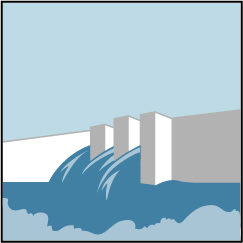
Hydro-electricity represents 8% of Canada’s primary energy supply and is the country’s dominant source of electricity, representing about 60% of total generation.
How do we use hydro energy?
Hydroelectric plants take advantage of falling water to generate electricity. The higher the drop (head) and the greater the flow, the more power can be produced. A large hydroelectric plant commonly has a dam backing up a reservoir. Power is produced when:
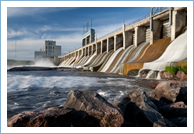
What are the environmental impacts of hydro energy?
Every river and every dam is different; therefore, the type and severity of impacts will vary. A dam’s environmental impact depend on:
Dams can affect the environment in different ways.
Water quality: Dams can alter the temperature and levels of dissolved gases within a river. These changes often prove harmful to the aquatic habitat and contribute to a variety of related water quality problems.
Flow of river-borne sediments: When a dam reduces the velocity of a river’s flow, sediment drops and collects on the bottom of the river and the reservoir where it can affect habitat for fish spawning. The loss of sediment downstream can degrade in-stream habitat and cause the loss of delta areas at the mouth of the river. The deposited sediment may also contain chemical or industrial residues from upstream sources which, when trapped within the dam’s reservoir, could result in the build-up of highly concentrated toxins.
Can dams be improved?
Changing the way a dam is designed or operated can reduce some of these impacts, by:
Hydro energy in the future
A new wave of small hydro-electric generators which have a much smaller environmental impact are being designed and installed all over the world. These are often called run-of-river designs, because they do not require reservoir impoundments. Part of the river's flow is channeled through the turbine and part of the river remains in the streambed. This allows the normal river processes to continue and eliminates the need to relocate the people who live upstream.
[top of page]
What is geothermal energy?
Geothermal energy converts heat from the earth's molten core into heat and electricity. For every 100 m you go below ground, the temperature of the rock increases about 3°C. At 3,000 m below ground, the temperature of the rock would be hot enough to boil water.
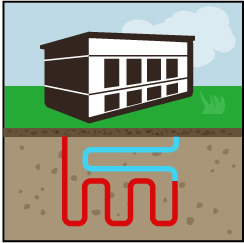
Geothermal energy is considered renewable because the nearly limitless amount of heat within the earth’s core continuously circulates between subsurface rock and underground reservoirs of water.

How do we use geothermal energy?
A. To heat and cool buildings
Almost everywhere on the planet, the temperature 3 m below ground level is the same, from 10 to 16°C. A geothermal, or ground-source heat pump, system uses that constant temperature to heat or cool a building. It does so by using the earth as a heat sink in the summer and a heat source in the winter.
A ground-source heat pump works much like the refrigerator in your kitchen except it has extra valves that allow heat-exchange fluid to follow separate paths for heating and cooling. Through a system of underground pipes, a ground-source heat pump transfers heat from the warmer earth to the building in the winter, and takes the heat from the building and discharges it into the cooler ground in the summer.
Ground-source heat pumps don't create heat like most other methods of home heating. They move it from one area to another. This makes them highly cost effective systems.
Ground source heat pumps use a closed loop of buried pipes containing a fluid that carries heat.
For heating in winter:
For cooling in summer:
B. To produce electricity
We can tap geothermal energy to make electricity under certain geologic conditions. In some regions, the earth's naturally occurring heat flow is near enough to the earth’s surface to bring steam or hot water to the surface and form a geothermal reservoir.
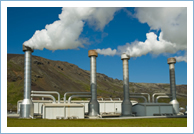
Geothermal reservoirs are classified as being either low temperature (<150°C) or high temperature (>150°C). High temperature reservoirs are suitable for commercial production of electricity.
What are the environmental impacts of geothermal energy?
When geothermal systems create steam, gases can be released into the atmosphere. These air emissions represent tiny quantities and generally do not pose a serious environmental threat. The chemical composition of the gases depends on the geologic site. Dissolved gases usually include carbon dioxide (CO2), methane, hydrogen sulphide, ammonia, nitrogen and hydrogen.
The disposal of water and wastewater may cause significant pollution of surface and ground water. However, in most cases, used geothermal fluids are collected and re-injected. This allows for recycling and reuse and maintains pressures in underground reservoirs.
The best geothermal resources are sometimes located in remote areas that have significant wilderness, scenic or recreation value. The geothermal plant itself requires relatively little land, but the environmental impact broadens when new transmission lines are connected to power plants in rural regions.
[top of page]
What is solar energy?
The sun is the ultimate source of much of the world's energy. It provides the earth with light and heat in the form of electromagnetic radiation.
Solar energy is our earth's primary source of renewable energy. The enormous flow of radiant energy supplied by the sun far exceeds what the world requires for electricity fuel.
While many technologies derive fuel from one form of solar energy or another, there are also technologies that directly transform the sun's energy into electricity. Since generating electricity directly from sunlight does not deplete any of the earth's natural resources, solar energy is a renewable source of energy.
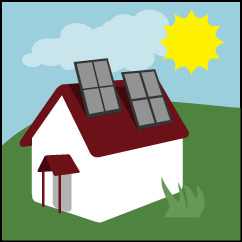
How do we use solar energy?
A. To heat water
Using the sun to heat water has the potential to be the most cost-effective use of solar energy. There are numerous, increasingly sophisticated technologies that can capture solar energy to provide households and offices with a significant percentage of their hot-water needs.
Active solar hot water heaters use roof panels that contain a network of black heat absorbent pipes. The sun heats a liquid in the pipes and is then pumped through a heat exchanger to warm household water. Domestic hot water and pool heating systems are the two most common uses of solar thermal collectors.
Solar hot water heaters are more promising than photovoltaic (PV) solar cells (which convert solar energy into electricity) because they are less expensive and capture a much higher proportion of the sun’s energy.
B. To heat buildings passively
Passive solar provides both heating and cooling to keep building occupants comfortable without mechanical equipment. Passive solar buildings use windows, walls and floors to absorb, store, release and distribute the sun's heat in the winter and reject solar heat in the summer. It also maximizes the use of sunlight for interior illumination.
C. To heat buildings actively
Active solar heating systems use mechanical equipment to collect and distribute solar energy to heat the interior of buildings. Active systems use collectors, which look like flat boxes covered with glass. The collectors are usually placed high up on roofs where they can collect the greatest amount of sunlight. Dark-coloured metal plates inside the boxes absorb heat from the sun. Air or water is then passed through the collectors, warmed and distributed to the rest of the house. Just like with an ordinary furnace system, thermostats are used to control the delivery of heat.
D. To produce electricity
There are two different technologies to generate electricity from the sun – Photovoltaic (PV) and Solar-thermal.
Photovoltaic (PV)
Photovoltaic solar technology relies on chemical reactions to generate electricity. PV cells are small, square-shaped semiconductors manufactured in thin film layers. They are made using silicon and other conductive materials. When sunlight strikes the PV cell, chemical reactions release electrons and generate an electric current. The small current from individual PV cells, which are installed in modules, can power individual homes and businesses. They can also be plugged into the bulk electricity grid.
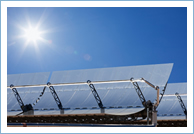
PV technology has limited efficiency and is expensive. However, as the technology improves, PV materials are being incorporated into construction materials like roofing, tiles and cladding. This makes economic sense for new building construction and major renovation projects.
Solar-thermal
Solar-thermal technologies are a traditional electricity generating technology using the sun's heat to create steam or pressurized gas to drive a turbine generator. These new solar-thermal technologies are now in use in some parts of the world.
Parabolic dish systems concentrate sunlight to heat gaseous hydrogen, helium or liquid sodium to create pressurized gas or steam to drive a turbine to generate electricity.
This is accomplished with a central receiver system which feature mirrors that reflect sunlight on to a large tower filled with fluid that when heated creates steam to drive a turbine.
What are the environmental impacts of solar energy?
PV and solar-thermal technologies generate zero emissions themselves but greenhouse gas emissions and other pollutants are created by their construction.
PV cell manufacturing generates some hazardous materials that need to be handled appropriately to minimize risks of exposure to humans and the environment. Solar panel construction requires rare metals, which leads to mining impacts on wildlife and water quality.
Water use for solar thermal plants is similar to amounts needed for a comparably sized coal or nuclear plant.
[top of page]
What is wind energy?
Wind power is the world's fastest growing electricity generation technology. Wind is a result of convection (caused by the sun’s heating effect) and the rotation of the earth. Daily and seasonal changes in temperature consistently generate wind, producing an energy source that can never be depleted. Therefore, wind is a renewable source of energy.
How do we use wind energy?
Wind energy can be used to produce electricity. Wind power plants use large spinning blades to capture the kinetic energy in moving wind. The energy is then transferred to turbines that produce electricity. The best sites for wind power plants have steady wind patterns and average wind speeds exceeding 16 km/h.
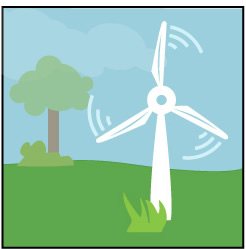
Wind power is cheapest renewable energy technology available on the market today. The cost of wind-generated electricity at prime sites is close to the cost of a coal-fired electricity. Because wind power is clean and the technology is always improving, wind power generation is expected to grow in the future.
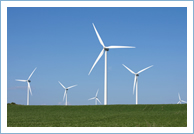
What are the environmental impacts of wind energy?
Wind plants produce no air pollution, use no water and do not impact the land. However, there are still environmental problems associated with some wind plants. Wind power generates three categories of environmental impacts, which can vary immensely from site to site.
Visual disturbance
Because wind farms have many turbines mounted atop tall towers, they can often be seen from far away. Some people find the man-made structures an intrusion on the natural landscape.
Noise pollution
Wind turbines, particularly older designs, emit noise that can be heard in the vicinity of the wind farms. The frequency and volume of this noise can be controlled, but not eliminated, by wind turbine design.
Wildlife injury
Early wind turbines had a detrimental impact on bird populations; however, this issue has been largely resolved by new turbine designs. Current wind turbine technology offers solid tubular towers to prevent birds from perching on them. Turbine blades also rotate more slowly than those of earlier designs, reducing the potential for collisions with birds. It is still important to locate wind farms away from migratory bird routes since bird kills are inevitable with any large structure, as seen with office towers in urban areas.
[top of page]
What is biomass?
Biomass is organic matter, usually from waste materials, such as:
In the future, much larger quantities of biomass power could come from crops that are planted and harvested specifically for use as an energy fuel source (e.g. poplars and willows in short-rotation plantations).
Biomass is considered to be a renewable source of energy because it is derived from materials that are easily regenerated from naturally occurring sources. Biomass materials can be used as a solid fuel or it can be converted into a liquid or a gas. Biomass is used to generate electric power, heat or chemicals for vehicle fuel.
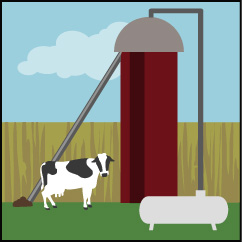
How do we use biomass?
A. To generate electricity
Most biomass power plants burn lumber, agricultural waste or wood waste from construction and demolition.

Some power plants burn the biomass fuel directly in boilers that supply steam for generators. This is called direct combustion.
Other power plants convert biomass into a gas (methane) that fuels steam generators, combustion turbines, combined cycle technologies or fuel cells. This is called biomass gasification.
Large municipal or industrial landfills produce gas that can be tapped to generate electricity. Microorganisms that live in decomposing organic materials such as food waste, paper or yard clippings produce this gas. Landfill gas is typically comprised of approximately 60% methane and 40% carbon dioxide (CO2). It is collected by drilling wells into the landfills and collecting the gases through pipes. Once landfill gas is processed, it can be combined with natural gas to fuel conventional combustion turbines. It can also be used to fuel small combustion or combined cycle turbines.
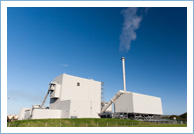
Methane generated from animal or human waste can also be captured for power generation or heating fuel. The City of Toronto’s sewage treatment plant, for instance, uses methane generated during biological fermentation of solid waste to provide free heat for the plant’s hot water requirements.
Because biomass technologies use combustion processes to produce electricity, they can generate electricity at any time. By comparison, wind and most solar technologies only produce energy when the wind is blowing or the sun is shining.
In 2007, biomass power plants had a combined capacity of 1578 MW, the third largest amount of renewable energy in the nation. They are common on a small scale in China and India where manure is collected to generate methane for cooking.
B. To power our vehicles
Biofuels are used in direct combustion and are typically used as liquid fuels for transportation. The two most common types of biofuels are:
Commercially available in parts of Canada, ethanol is already making a contribution to renewable, domestic, transportation fuels. It can be used in low concentrations (<10%) in regular gasoline engines, or at higher concentrations in specially adapted engines.
Biofuels offer many benefits. When produced on a small scale, they can be good for the environment because they add fewer emissions to the atmosphere than petroleum fuels. They also utilize waste materials that have no other use. However, their environmental benefit depends on how they are used. In some cases, a modest benefit is possible.
What are the environmental impacts of biomass?
Biomass energy production can have a negative effect on the environment. For example, biomass power plants generate air emissions. These emissions vary depending upon the fuel and the technology used.
If wood is the primary biomass resource, very little sulphur dioxide (SO2) is emitted. Sulphur dioxide contributes to acid rain.
Some biomass power plants that use combustion technologies have high nitrogen oxide (NOx) emissions. This is because many biomass fuels have high nitrogen content. This high NOx rate is one of the top air-quality concerns associated with biomass.
Biofuel power plants also emit carbon monoxide (CO), sometimes at levels higher than coal plants. They also produce carbon dioxide (CO2), which is the primary greenhouse gas responsible for climate change. However, the cycle of growing, processing and burning biomass recycles CO2 from the atmosphere. If this cycle continues, the level of CO2 in the atmosphere does not increase.
The collection of biomass fuels can also have significant environmental impacts. Harvesting timber and growing agricultural products for fuel requires large volumes to be collected, transported, processed and stored.
Sometimes the biomass fuel source contains toxic contaminants. For example, agricultural waste handling pollutes local water resources.
Burning biomass deprives local ecosystems of nutrients that forest or agricultural waste may otherwise provide.
In a world where food is increasingly scarce, the production of biofuels can divert agricultural crops away from food.
Environmental advantages
Managed production of biomass fuels recycles CO2 in one-third less time than natural processes. This is because short rotation crops of woody plants can be matured and harvested in less time than natural growth forests.
Biomass power plants also divert wood waste from landfills. This wood waste produces methane, another potent greenhouse gas, into the atmosphere.
Biomass fuels may be obtained from supplies of clean, uncontaminated wood that otherwise would be sent to the landfill. They may also come from sustainable harvests. In both of these fuel collection examples, the environmental benefits of biomass are significant. This is especially true when compared to fossil fuel collection alternatives.
Did you know?
Biomass power is the largest source of non-hydro renewable electricity in the world. It generates an estimated 47,000 MW worldwide.
In Canada, biomass energy provides about 5% of our energy supply. The pulp and paper industry has about 650 MW of electricity generating capacity, fueled in part from the combustion of residues such as chips, saw dust, bark and other industrial wood wastes.
[top of page]
What is tidal power?
The world’s oceans represent a continuous, renewable source of energy, which can be harnessed to provide power for our homes and industries. There are two basic ways to tap the ocean for its energy: we can use its waves or its tides to generate power.
Waves are a free and sustainable energy resource created as wind blows over the ocean surface. The greater the distances involved, the higher and longer the waves will be. Energy is stored in this way until it reaches the shallows of costal areas where it is released.

Tidal power generates electricity by harnessing the power of tidal motion. The ultimate source of this energy is gravity. The moon and sun exert gravity on the nearest ocean mass, creating an imbalance on the water further away. This results in a relative height difference that we see as tidal movement. The range of these tides depends on the relative location of the moon and the sun to the earth.
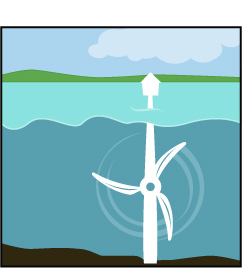
How do we use wave energy and tidal power?
Wave energy and tidal power can be used to create electricity.
Wave energy
Kinetic energy (movement) of ocean waves can be harnessed and used to power a turbine to produce electricity.
A common means of harnessing the kinetic energy of waves is through the use of a wave chamber. As wave rises into a chamber, the rising water forces the air out of the chamber. The moving air spins a turbine that can turn a generator. When the wave goes down, air flows through the turbine and back into the chamber through doors that are normally closed.
Other wave-energy systems use the up-and-down motion of the wave to power a piston that moves up and down inside a cylinder. That piston, in turn, spins a generator to produce electricity.
Most wave-energy systems are very small, providing only enough energy to power a warning buoy or a small lighthouse. However, larger-scale projects have been developed such as a 750 kW wave farm project off Islay, Scotland and a 2 MW project off the coast of Vancouver Island, Canada.
It is anticipated that these and other projects will form the basis for larger, multi-machine 'wave-farms'. A typical 30 MW installation would occupy a square kilometre of ocean and provide sufficient electricity for 20,000 homes.
Tidal power
The basic physics and engineering behind tidal power generation are relatively simple.
When using tidal power, it is often difficult to match supply and demand of electricity. Electricity demands peak at certain times of day, depending on the climate. These peak times of power demand don’t always match the peak times of power output because the tides are dictated by the lunar cycle.
As a result, tidal power plants usually require a backup system to meet demand. These backup plants often operate on fuel oil or natural gas. When you combine the cost of the tidal plant and the backup plant, tidal power can be quite expensive.
What are the environmental impacts of tidal power and wave energy?
Tidal power plants have a significant impact upon the local ecosystem because they are built across large estuaries. Estuaries often play host to migratory birds who feed on worms and other invertebrates found on the exposed mudflats. Building a large barrier across an estuary affects water-level variations, decreasing the areas of mudflats exposed each day. The barriers also reduce the flow of sediments from the estuary, which alters the biological productivity of the ecosystem.
While wave-energy systems consume no fuel during their operation and as such, have no emissions of harmful pollutants, they can still impact their immediate environment. Large-scale wave-energy systems can: